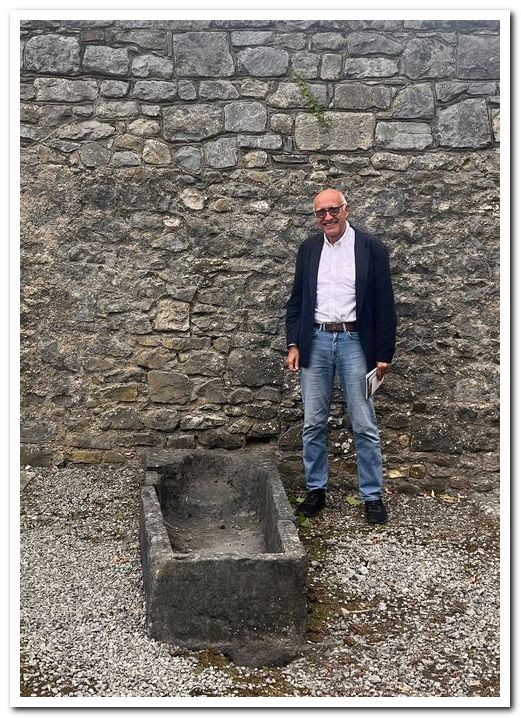
 It’s not every day you find the tombstone of your 800-year-old ancestor and get your photo taken by Jesus!
It’s not every day you find the tombstone of your 800-year-old ancestor and get your photo taken by Jesus!
Last week an Englishman who lives in Scotland came to Kilkenny to see the tombstone of one of his ancestors. Nothing unusual in that—but this one stretches back nearly 800 years.
Cliff Shardalow, in his late 60s, came to see his twenty-times great grandfather’s tombstone in the yard outside the Black Abbey. Robert de Sardeloue died in 1255. The evidence that he is Cliff’s direct male-line ancestor is strong.
Cliff met up with members of the Kilkenny Archaeological Society to fill in some history. Patricia explained that the tombstone was found by the society in 1851 in Blackmill Street during building work. The stone lay beneath the floor of a house. Blackmill Street was once the burial grounds adjacent to the Abbey. They searched for bones, but water prevented excavation—so Robert still lies there.
The Abbey booklet describes the tombstone as “perfect, with raised floriated cross and inscription in Norman French and in Lombardic lettering.”
It also notes that “In the White Book of Ossory, a Canon of St. Canice’s Cathedral, Robert de Sardaloue witnessed a grant dated between 1245 and 1250.”
When Cliff visited on Tuesday, 2 September, he located the tombstone (the 7th one from the road) and got a local man—waiting for a rehearsal of The Man Born To Be King, in which he plays Jesus—to take the photo.
Robert de Sardeloue was born in England, likely in Shardlow between Derby and Nottingham, in 1200. His name appears in various forms: Sardalove, Shardelow, Schardelowe. He was a Justice by age 20 and was sent by King Henry III to Rome in 1227. In the 1230s and 40s, records show land ownership and disputes with the crown. His brother Hugh was imprisoned in the Tower of London.
Robert served as a Justice Itinerant, traveling county to county. In 1246, he was sent to Ireland in that role. His duties included widow estate claims (unde nihil habet), land disputes (novel disseisin), and clerical appointments (darrein presentment).
In 1247, he witnessed a land transaction in Gormanston, north of Dublin. Around 1250, he held land in Skiboo/Swords. By then, Henry III relieved him of some duties near Athlone.
In 1279, four years after his death, his sister Isolda was held responsible for some of his debts.
Robert had two sons and a daughter: Edmund (Cliff’s ancestor), Geoffrey (d. 1274), and Petronilla. Geoffrey inherited a small estate in Ireland, possibly exchanging it for property in Knightstown. By Edmund’s son’s generation, the family had moved to East Anglia, remaining there for 600 years. They held ecclesiastical and judicial roles for several generations, including building a church and college in Thompson, Norfolk. By the 19th century, the family had moved to London and were poor.
Cliff’s research (not verified by historians) includes the Norman arrival in Ireland (1167–69), invited by Diarmait Mac Murchada, King of Leinster. Richard de Clare (Strongbow) succeeded him. In 1171, Henry II was recognized as overlord by Irish and Normans, beginning centuries of English involvement.
The Normans quickly controlled most of the land and developed English-style governance. However, Gaelic Irish resisted. Edward Bruce’s failed rebellion in 1315 was the last major challenge. By the late 15th century, English rule had shrunk to the Pale around Dublin.